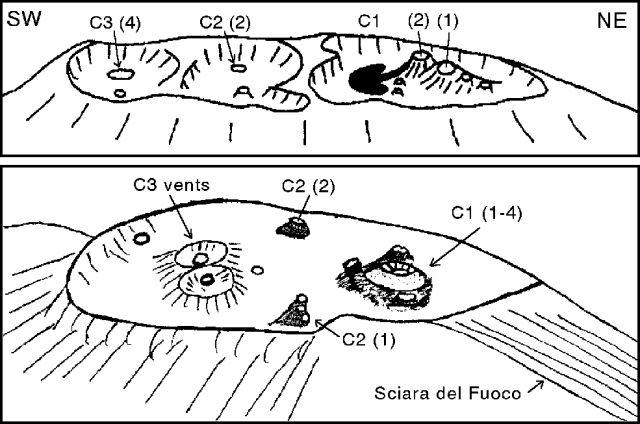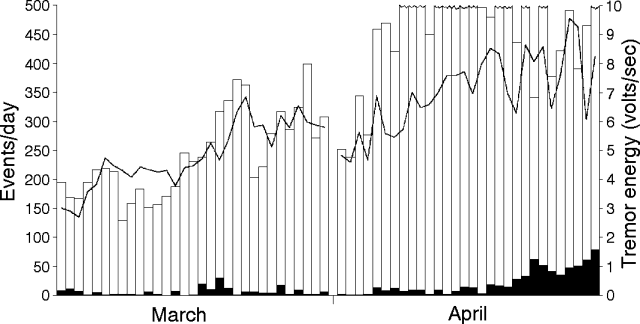Report on Stromboli (Italy) — April 1993
Bulletin of the Global Volcanism Network, vol. 18, no. 4 (April 1993)
Managing Editor: Edward Venzke.
Stromboli (Italy) Explosive activity increases; detailed description of crater
Please cite this report as:
Global Volcanism Program, 1993. Report on Stromboli (Italy) (Venzke, E., ed.). Bulletin of the Global Volcanism Network, 18:4. Smithsonian Institution. https://doi.org/10.5479/si.GVP.BGVN199304-211040
Stromboli
Italy
38.789°N, 15.213°E; summit elev. 924 m
All times are local (unless otherwise noted)
Steve Matthews and Abigail Church observed vigorous Strombolian activity on 22 April at two 20-m-high hornitos in crater C1 (figure 29). Incandescent gas explosions occurred at 3-10 second intervals, followed ~0.5 seconds later by ejection of spatter. Semi-liquid bombs up to 2 m across reached up to 100 m above the vents. Stronger activity from all three craters every 10-20 minutes consisted of gas emissions lasting as long as 15 seconds that ejected spatter as high as 250 m. These stronger events appeared to occur in pairs from craters C3 and C2. An explosion from C3's vent 4 was often followed a few minutes later by an explosion from vent 2 in C2. Within C1, these larger explosions were only produced from the NE hornito (vent 1). Many incandescent fumaroles were visible on the hornitos and the floors of all three craters. Small amounts of spatter were also ejected from the fumaroles during the strongest explosive episodes. At about 2030, shortly after sunset, lava was observed flowing slowly from a breach or bocca in the SW hornito (vent 2) in C1. When observations ended at 2200, the lava flow had divided and was beginning to form a moat around the hornitos.
A high level of eruptive activity was reported by Steve O'Meara on 2-6 May. Roaring noises could be heard in San Vincenzo (~2.5 km NE) the afternoon of 2 May, which became periodic by late afternoon, occurring about once every 20-30 minutes. A gray fountain was observed from the lower NE slopes around 1830 that rose several hundred meters above the NE-most vent. Several strong explosions later that evening sent incandescent boulders rolling down the steep slope of the Sciara del Fuoco (figure 29). There were at least 8 vents active for several hours during summit observations the night of 3-4 May. Eruptive activity increased dramatically after the nearly full moon rose, peaked when the moon culminated in the southern sky, and waned before moonset. Lunar perigee (when the moon is closest to the Earth) occurred that night around 0100.
Vent 1 in crater C1 (figure 29) was a large dome-shaped mound with a summit crater and shallow floor filled with incandescent bombs from other vent explosions. Approximately every 30 minutes a powerful explosive blast, which sounded like a large cannon firing, violently blew the debris from the vent to heights of 200-300 m. Increased crater glow preceded these eruptions and most others. C1's vent 2 is a small cone with a peanut-shaped throat adjacent to and W of vent 1. This vent was continuously active with jetting sounds, blue flames, and spatter ejection. Thin streams of lava were erupted about every 5 minutes, with larger 100-m sprays of lava about every 15 minutes. Vent 3 in C1 (E of and adjacent to vent 1) exhibited continuous glow and erupted synchronously with either vent 1 or vent 2, ejecting material to a height of ~100 m. Occasionally, vents 1-3 would erupt together. Ejecta from vent 3 was directed slightly NE, while blasts from vents 1 and 2 were directed vertically. These explosions only lasted for a few seconds. Another less-active vent in C1, S of and adjacent to vent 1, also appeared to erupt synchronously with vents 1-3 to heights of tens of meters.
In crater C2, vent 1 had three glowing components, though only the western-most one produced sporadic minor eruptions, spraying lava ~10-30 m above its steep, narrow cone. Eruptions from vent 2 in C2 occurred every 30-45 minutes and lasted 20-40 seconds each. Eruptions began with a strong jetting sound, after which a thin spray of lava would shoot out, followed by more vigorous jetting and extensive lava production. Lava fountains reached heights of up to 150 m. Lava was visible in the vent for about a minute after each eruption, with the surface continually being fractured by escaping gases. The lava would then slowly sink into the vent until it was no longer visible, although glow remained.
Two small adjacent vents in crater C3 were each surrounded by wide, shallow cinder rims. Eruptions were more frequent at the W vent, where explosions sent material 300-400 m high about every 10 minutes during the most active periods. These eruptions occurred without warning and were accompanied by a loud roaring noise. The largest eruptions from this vent produced very broad, expansive plumes shaped like large evergreen trees, which reached 30 m above the summit of the volcano. Another vent farther S may also have erupted, but that area was obscured by fumes and steam.
The frequency of eruptions from each vent changed with time, but not the sounds, making it possible to know which vents were erupting. By the morning of 3 May, activity had declined to one large explosion and a couple of smaller ones approximately every 20 minutes. During the most active periods of the night, >20 strong eruptions occurred every hour. Activity increased again after moonrise on 4 May and remained strong into the early morning. Orange glow reflected by the clouds was observed that night in San Vincenzo. The next day, powerful eruptions continued from crater C3 and vent 1 in C1, but with less frequency. Vents 2 and 3 in C1 glowed but did not have any strong eruptions. Observations ended about 2400 on 5 May. Seven eruptions were seen from the ferry 2100-2200 on 6 May.
Marcello Riuscetti reports that Stromboli guides observed a new cone in crater C1 and renewed activity at the C3 spatter cone in mid-May. On 16 May a small lava emission occurred from the base of a cone in C3. During the night the flow traveled 30 m down the slope, reaching the feeding fissure of the 1985 eruption before stopping. The flow resumed 18 May, covering ~60 m of 1985 lava NE towards the Sciara del Fuoco. Strong tremor and frequent explosions accompanied the lava flow.
Seismicity (number and energy of shocks, tremor energy) increased in March and April after the low of 11 February (18:02). The level of seismicity was very high in April (figure 30), with nearly continuous explosions in the second and third weeks.
Geological Summary. Spectacular incandescent nighttime explosions at Stromboli have long attracted visitors to the "Lighthouse of the Mediterranean" in the NE Aeolian Islands. This volcano has lent its name to the frequent mild explosive activity that has characterized its eruptions throughout much of historical time. The small island is the emergent summit of a volcano that grew in two main eruptive cycles, the last of which formed the western portion of the island. The Neostromboli eruptive period took place between about 13,000 and 5,000 years ago. The active summit vents are located at the head of the Sciara del Fuoco, a prominent scarp that formed about 5,000 years ago due to a series of slope failures which extends to below sea level. The modern volcano has been constructed within this scarp, which funnels pyroclastic ejecta and lava flows to the NW. Essentially continuous mild Strombolian explosions, sometimes accompanied by lava flows, have been recorded for more than a millennium.
Information Contacts: S. Matthews, Univ College London, London; A. Church, Natural History Museum, London; S. O'Meara, Sky & Telescope; M. Riuscetti, Univ di Udine.



